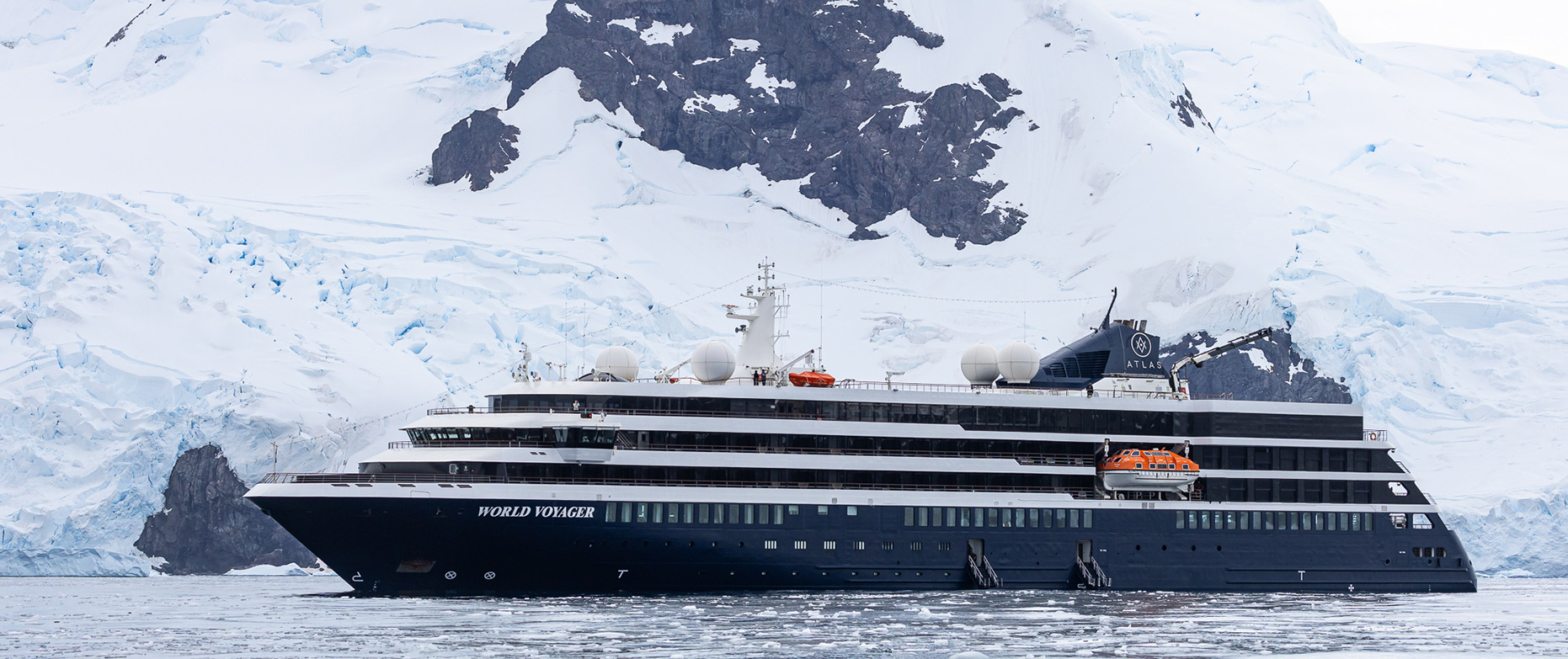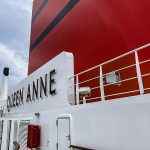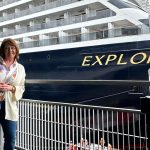Heading out on an expedition cruise to Antarctica is an adventure like no other!
Our Commercial Director, Ian, recently set off on this icy escapade aboard the World Voyager, one of Atlas Ocean Voyages‘ ships. After his return, we caught up with him to chat about his incredible journey.
You have travelled worldwide, so why did you choose to visit Antarctica?
Two things prompted our visit. Firstly, a dear friend told us about his own journey there late last year. Secondly, my wife’s adorable two-year-old granddaughter made a heartwarming request for a penguin photograph.
What made you choose the actual voyage you booked?
While we appreciate comfort, our travel desires lean towards unique adventures that leave a lasting impression. So, the “cruise” we were seeking wasn’t just about luxurious amenities. It had to offer a profound connection to Antarctica, a journey that would forge a powerful bond between us and this incredible continent.
We chose a sailing that turned out to be the most extraordinary experience of our lives. We sailed aboard Atlas Ocean Voyages’ 10,000-ton World Voyager, one of three near-identical yachts built for this relatively new, luxury, small-ship expedition operator. The itinerary and duration were just what we wanted; they were fantastic value. Her godmother is none other than Britain’s record-breaking polar explorer, Captain Preet Chandri, who is a serving officer in the Royal Army Medical Corps.
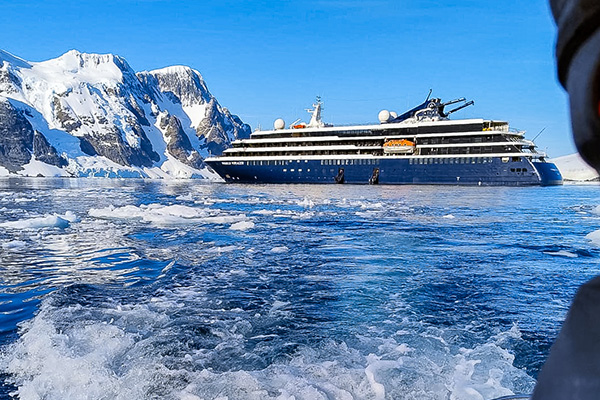
World Voyager in Antarctica
Did you need to do a lot of planning for this trip?
Only when we started thinking about packing did we fully appreciate just how great a distance home is from Antarctica. Cape Town and Buenos Aires are about 12 hours from London. From where Atlas World Voyager would sail, Ushuaia is a further three-and-a-half hours’ flying time south of Buenos Aires. Antarctica itself is another full two-and-a-bit days sailing south of Ushuaia.
We had to shop for thermal hats, ski pants, two pairs of waterproof cold-weather gloves, and thermal underwear, all found inexpensively online and in a high-street outdoor activity shop. Atlas Ocean Voyages lends passengers comfortable, well-insulated boots, and everyone is given a fully lined parka coat to keep.
When we packed, we had to give particular thought to the weather. Buenos Aires would be about 25 degrees Celsius, Ushuaia would be like a winter’s day back home, and Antarctica could be anything from minus five to minus fifteen degrees in early March.
Was the cruise easy to book?
Booking was super-easy, and Atlas’ UK sales office did everything for us. We were very impressed. Our fly-cruise package included return scheduled flights, a night pre-cruise stay in Buenos Aires, round-trip flights to Ushuaia on a plane chartered by Atlas, a complimentary tour to Tierra del Fuego National Park before sailing, a night in Buenos Aires after the cruise plus all associated transfers. We wanted to add a few extra days in Buenos Aires both before and after our cruise, and we did so with the greatest ease as part of our package.
You travelled on Iberia rather than British Airways. Were you nervous about flying on non-English speaking airlines and changing planes?
We did – because we both had to work on Friday, we flew, and Iberia had a flight at 7.15 pm (from Gatwick – our nearest airport). We opted to change to Madrid; we would have had to take a half-day leave from work to make the BA flight, so Iberia was perfect for us.
We made our connection comfortably, taking off at midnight and arriving at 8:15 am the following morning. The inflight service, catering, and entertainment were excellent, and we earned our Avios points! The return journey was equally easy and on time.
What sort of arrangements did Atlas have in place at the hotel in Buenos Aires?
We arrived at the InterContinental hotel not long after 10.30 am and therefore expected that our room wouldn’t be ready until that afternoon. However, the hotel knew we were Atlas clients, and we had room keys in our hands by 10.30 am. It’s a well-located central hotel with all the mod cons.
Atlas’s agent had a desk in the lobby providing on-site assistance and briefing each cruise client on luggage collection and coach departure instructions for the charter flight (we received our briefing a few days after arriving as we had an extended stay).
On departure day, Atlas’s agents were out in force. We left the hotel at 4.30 am after a light breakfast and were shepherded through ID checks to the gates. When it arrived, we were loaded onto the on-time FlyBondi B-737-800 aircraft. We took off at 7.00 am and landed at 10.45 am.
What was Ushuaia like?
As we flew over the sea, we first saw the snow-tipped mountains and the rippling waters of the fjordlands of Tierra del Fuego. The city is a mix of prefabricated and traditional buildings. The newer they are, the better insulated they appear to be. Most were low-level, rarely more than two stories high, and generally painted in bright colours. The airport at Ushuaia is friendly and small. It made me think of IKEA as it’s all pinewood and decorated in Scandi style. Bags came through very quickly.
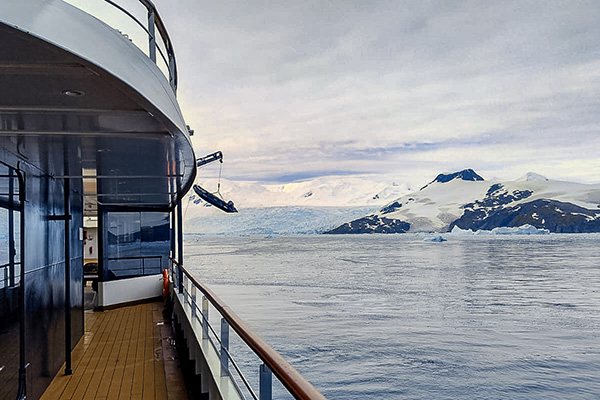
Word Voyager lowering a zodiac in Antarctica
Was the tour of the Tierra del Fuego National Park enjoyable?
The scenery is stunning, and we could stop and explore three distinct locations, including “the post office at the bottom of the world”, a shack on a pier where you could mail home and even get a passport stamp for US $20. As it’s the southerlyest point on the planet, we decided to have a paddle!
How was the embarkation process?
When we arrived at the port of Ushuaia at about 3:30 pm, the pier was “rammed” because Holland America had a massive cruise ship taking up one side of Ushuaia’s double-sided pier. On the other side, five expedition cruise ships were parked back to back, but not ours! That meant we had to embark by tender.
Embarking by tender is fantastically exciting; it makes you feel like the cruise has already started. As we peered through the windows and saw Atlas World Voyager in the bay, we all started talking and making friends, and any thoughts of a grumble evaporated when we climbed aboard.
Uushered to the comfortable Atlas Lounge and offered champagne and canapes, we were personally greeted by members of the expedition team, who collected our health declarations and swiped our credit cards for incidentals. We were then joined by the maître d’, who came to talk to me about my food allergies (which were taken care of without exception every day).
Did you like your accommodation?
Atlas World Voyager boasts just 86 suites and staterooms, most with private balconies. On our departure, we had 152 guest passengers plus 17 expedition staff aboard, a combination of expert naturalists, marine and avian scientists, wildlife photographers, zodiac drivers, sea kayak experts, and experienced guides and expedition experts.
We had a terrific Navigator suite with a double balcony, a large sitting room with a Nespresso machine, a well-stocked fridge and a separate bedroom. There were bags of storage space, and we had a huge bathroom with a big marble bath, a separate rainforest shower and twin hand basins. The balcony was lovely and deep. The sheets and towels were luxurious Egyptian cotton, we had large TVs in the lounge and the bedroom, there was lots of storage, and the decor was modern and luxurious.
Tell me about your cruise down to Antarctica?
It’s a long way from Ushuaia, the most southerly mainland city in the world, to Antarctica. We spent two full days sailing. On the way down, despite a cluster of cruise ships in port when we sailed, we saw just one en route and enjoyed very calm, almost waveless seas, something the experienced Norwegian Captain called “the Drake Lake.”
On our second morning, we spotted icebergs in the distance. The thrill amongst our fellow guests was palpable as people dived for cameras and went outside despite the windchill, which was a solid minus 8 celsius, and the overcast skies. Antarctica was just over the horizon.
You told me you are a bit of a nature nut. Tell me about your experiences in Antarctica.
I guess there is an inner fear about a vast expanse of open sea. But we had crossed it without so much as a bounce or a roll and the next day, we woke to the bluest of skies – it was cold, very cold, but the sun was high (ish). We were off Cierra Cove in a bay filled with carving and melting icebergs, from as small as a bath to as big as a mansion. And the backdrop was of massive sun-kissed glaciers pouring down into the sea. It was breathtaking – and around us flew Petrels and Abatross, Sooties and Skuas.
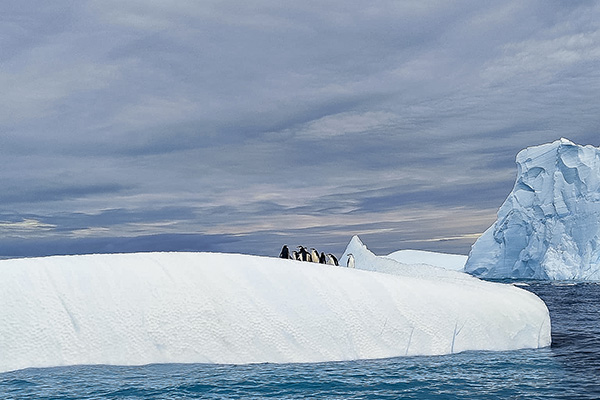
Cierra Cove
After breakfast, we rushed to put on our cold-weather gear as everyone was heading off for the morning on guided zodiac tours. Besides the extraordinary mix of icebergs in the bay, we had colonies of penguins to discover, so in organised groups, we departed zodiac by zodiac for about 90 minutes. We saw three colonies of penguins: one Chinstrap and two Gentou, and Leopard seals hunting, basking Fur and Weddell seals. On our return journey, Humpback whales were feeding on the abundant krill.
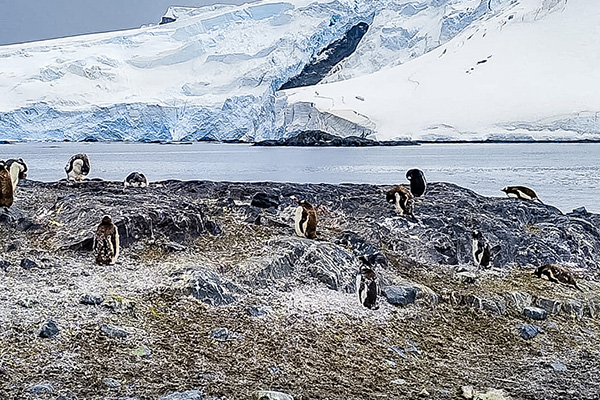
Chinstrap Penguins
The morning excited us hugely, and after lunch, we landed at D’Hainault Island in Mikkelsen harbour. Again, we embarked on the zodiacs; this time, they beached so we could swing off and follow a clearly identified path to better explore the island. Favoured by whalers of old, the desiccating remains of whales litter the shore, as does an abandoned waterboat. We climbed a small hill and looked down on a vast colony of Gentoo penguins basking in the sun, strangely with Fur seals in and amongst them. On land, the birds are too quick, so the seals pose little threat to them.
The following day, we sailed ever so slowly through Lemaire Channel. Surrounded by majestic glaciers and mountains, the air was so clean (cold, of course), and the majority of passengers were out on deck with their cameras. Later in the morning, Pleaneau Bay made the iceberg graveyard we had seen the previous morning seem insignificant! The extraordinary shapes, the natural blue of the ice, the massive glaciers bearing down on the water’s edge and the sparkling sun on another cloudless blue sky in the morning took our breath away.
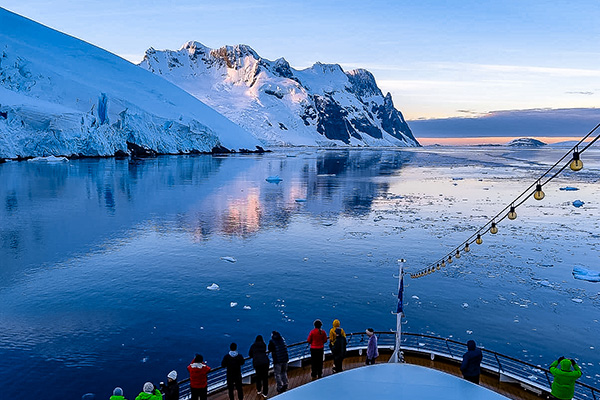
View of Iceburg in Antarctica
Our morning zodiac safari took us up close with to bergs of all shapes and sizes, from twin-headed ones connected under the water (known as dry-docks) to small ones and ones the size of football pitches. Leopard seals love the bubbles from the outboard motors on the zodiacs and came to play with us. More were basking in the sun, so too groups of Fur Seals and colonies of Gentou and Chinstrap penguins. Humpbacks were feeding in the bay.
Atlas did not publish exact excursion itineraries more than 24 hours ahead as everything is dependent on weather, local conditions and what’s going on with the local wildlife. On our second afternoon, the shore landing was cancelled as the colony of seals there was “rather frisky” and likely to be dangerous, so as the weather was fantastic and the sea was like a mirror, we did our Antarctic Plunge. 92 of 152 fellow lunatics jumped, dived or jack-knifed into the freezing cold sea. It was simply exhilarating.
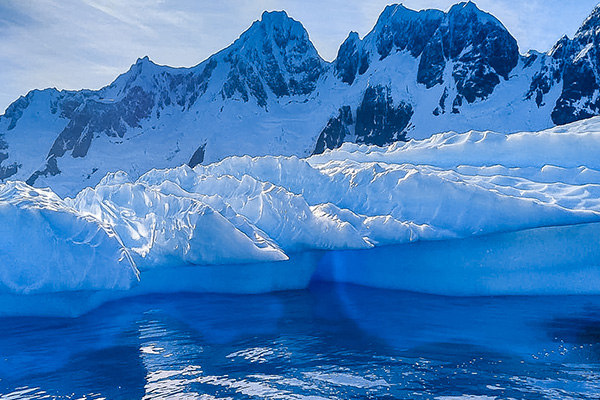
Close up of Iceburg
The following morning, we had hoped to land at Port Lockroy but were unable due to the spread of avian flu – a genuine concern in Antarctica, which scientists are working hard to irradicate. Instead, we cruised towards Useful Island, watching families of Humpback whales feeding and were in awe at the proportions and shape of the many icebergs we passed. At Orne Harbour we discovered colonies of Chinstrap penguin close by the Almirante Brown Antarctic Base, saw Crabeater and Fur seals and wondered at the extraordinary lenticular cloud formations as we climbed to a caldera rim to look down on our beautiful ship and natures feast.
At Enterprise Island, we saw a wreck. The Governoren, a Norwegian whaling ship, was once full of whale oil, which ignited, causing her to be abandoned in 1915. The crew of 85 survived the disaster and were rescued a few days later. Today, the wreck is an absolute haven for Antarctic Terns and a small colony of Antarctic Cormorants.
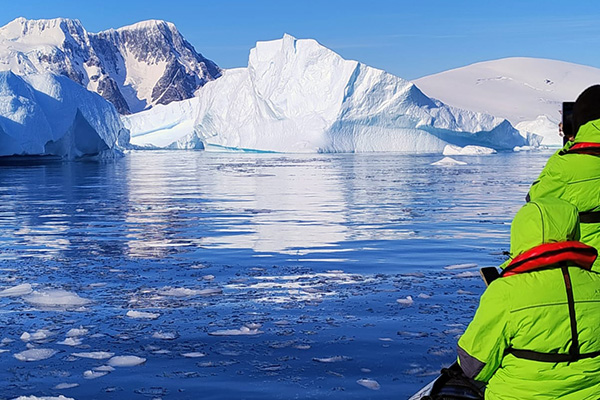
Zodiac Safari
The weather was closing in as we embarked on our final zodiac safari. But what a safari it was. The bay was rich in Growlers (these are bergs smaller than 1m above the sea) and Bergy Bits (yes, that’s the scientific name for bergs smaller than 5m above the sea), and there were three groups of whales feeding, both Minke and Humpbacks. We saw Leopard seals, Crabeater, Weddell and Fur seals, Gentoos, Chinstraps, and Rockhopper penguins plus the Sooty and the Wandering Albatross, Arctic Terns (yes, all the way down south), the Kelp Gull, four varieties of Skuas, Wilsons Storm-Petrel, Antarctic Petrels, Snow Petrels, the South Georgia Shag kept and the Antarctic Prion.
What did you like about Atlas World Voyager?
She is beautiful and thoughtfully laid out. Eight decks high and 129m long, she comfortably rode the choppy weather we had on our return to Ushuaia. All the bedrooms were beautifully planned with L’Occitane toiletries and all the luxuries you would want, including a rain shower. We loved being able to order breakfast to our room most mornings and appreciated having the in-room bar restocked with soft drinks and beer each day.
Deck 4 is the main “social deck”. Aft is the beautiful, airy Madeira Dining Room, where breakfast and lunch are served buffet style, with full service at dinner. Breakfast was a generous selection, as expected in a 5-star hotel. Lunches were a clever mix of comfort foods, salads, desserts and international treats. Dinner each night was an ever-changing selection of world cuisine, beautifully presented.
Amidships is the medical centre, the hotel manager’s office and desks where we could meet, book another cruise or chat with the Expedition Team, who used this area to plan and advertise our daily off-ship experiences. Close by is Paula’s Pantry, an informal café open from 6.30 am to 6.30 pm daily, the Fitness Studio, the L’Occitane SeaSpa and Sauna that offered a selection of favourably priced massages and luxury treatments, which we both enjoyed. The Boutique had everything we might need, plus lots of mementoes we bought – including cuddly penguins.
Further forward, the comfortable Atlas Lounge has full-height windows on either side. Beyond it is a two-deck-high, beautifully designed lecture hall where daily round-ups, information briefings, and natural history lectures are presented.
Down on deck 3 is the mudroom, where boots, coats and other expedition kit is stored, and from where we embarked the zodiacs. On Deck 5, a heated forward observation seat called The Waters Edge is a lovely spot to watch the sunset. At the opposite end of the ship is the Zephyr Lounge provides an equally broad horizon.
The Dome, a beautiful panorama lounge forward on Deck 7, was the place to be as we sailed in and through the islands and passages of Antarctica. Afternoon tea was served here daily, and it was the perfect place for after-dinner drinks and chat about our day’s adventures. There is decking in front and to the sides of the Dome, which we regularly darted out to with every new sighting. The pool, two Jacuzzis, and the 7Aft Grill and Bar are just behind here. These don’t normally open in Antarctica, but we had one lunchtime that was so sunny that it opened up serving grill items, and we all enjoyed alfresco. Up on deck 8 are bags of viewing and observation space, plus a running track.
How “inclusive” was your cruise?
Wines with meals, champagne, and drinks before and after dinner and in our cabin were all included, as were tips. Also, all the zodiac safaris and shore landings were included because we sailed in Antarctica. You could buy “extra” excursions, which on this voyage was the chance to sleep out on the great white continent, to go sea kayaking and to paddleboard.
In a paragraph, sum up your overall experience?
Despite being a small ship, Atlas World Voyager is incredibly stable. She was spacious and comfortable and had every facility, service and quality we wanted and expected of a luxury ship or resort. Atlas’s care and attention to detail was fantastic, and they gave us a holiday experience like no other. We’d recommend them in a trice.
If you have any questions or comments, leave them below or contact me directly by emailing Ian@cruiseline.co.uk.

